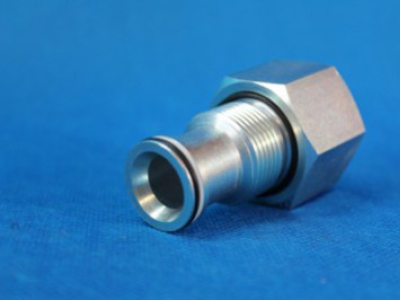Power beyond - also called high-pressure carry over (HPCO), is a function of a mobile hydraulic directional valve. It allows you to isolate the pressure gallery from the tank gallery, and then transfer it to an additional valve - usually to another directional valve. This allows the pressure gallery to be moved or continued to another directional control valve (DCV) port. Power Beyond is DCV or High Pressure Carry Over (HPCO).
The Power beyond Valve Sleeve enables the correct connection of an additional valve and its connection after another valve. High pressure prevents damage to the outlet or return ducts and slide seals of the control valve. The return duct is blocked from the normal outlet, therefore it is necessary to provide an additional outlet that should be connected to the tank or tanks.
.jpg)
.jpg)
The directional control valve is responsible for controlling the direction of fluid flow in the hydraulic system. This device redirects or stops fluid flow by means of an internal mechanism in the valve. The valves have special ports, which are external holes for the liquid to enter and exit freely through the connecting pipelines. The number of ports (holes) on the directional control valve, ie DCV, is usually referred to as "way".
Control valves (DCV) due to the occurrence of various types are classified based on the fluid path. There are valves:
-
Check valves
-
Shuttle Valves
-
Two-way valves
-
Threeway valves
-
Fourway valves
The check valves allow fluid to flow only in one direction. To open the valve seat in a given direction, the necessary pressure is needed to allow fluid to flow through the inlet. The valve opens when fluid flows through the inlet. When the flow is in the opposite direction, the valve shuts off. The pressure that flows in the opposite direction presses the ball against the valve seat, thus closing the path.
The Shuttle Valves is a three-way valve that allows fluid to flow in two different directions. When the flow pressure increases on one side, the valve closes the other path. Check valves are used when there are two pumps in the device, because if one of the pumps does not maintain the outlet pressure, the other provides the flow as a reserve.
Two-way valves are also called simple , two-position ON / OFF valves. These valves are actuated by cylinders, e.g. electromagnetic or hydraulic cylinders. Two-way valves need external actuation to change the position of the valve actuator. The fluid flow path is opened or closed when the actuator is moved.
.jpg)
Three-way valves for valves that are three nodes. These valves contain two plugs actuators, each flow control plugs works in two different ways. Closure plugins open or close nodes. This normally closed valve neutralizes the position of the actuator closing both nodes to close the valve. Three-way valves in versions for manual, mechanical, pilot and electromagnetic actuation.
A fourway or three-position valve is a valve that has three operating positions for servomotors for controlling the flow direction. These valves are usually used to hydraulically drive cylinders and hydraulic motors in both directions. When choosing a four-way valve, we have a choice of manually controlled, mechanically, electromagnetically, pilot and pneumatically controlled models.
.JPG)


.JPG)
.JPG)